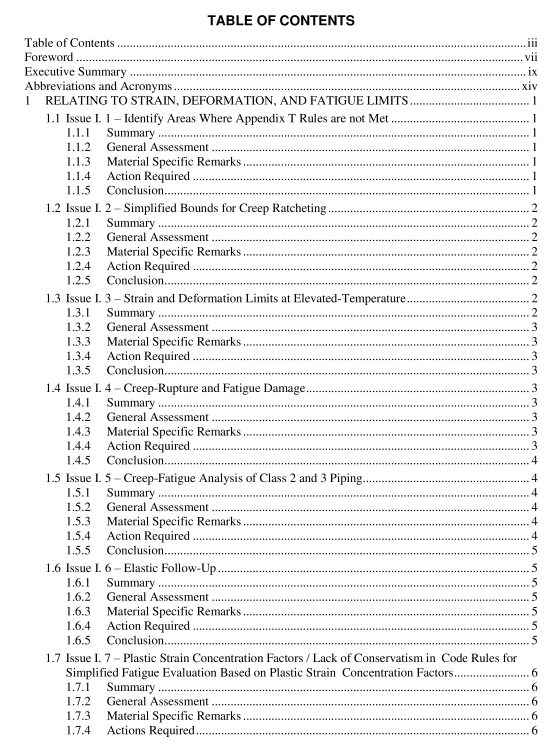ASME NTB-3:2020 pdf download Gap Analysis for Addressing Adequacy or Optimization of ASME Section III, Division 5 Rules for Metallic Components
1.4.5Conclusion
Tentatively categorized as optimization.
1.5lssue l.5-Creep-Fatigue Analysis of Class 2 and 3 Piping1.5.1 Summary
From O’Donncll, Hull and Malik’s Item OG- 7:
If the operating temperatures for Class 2 and 3 piping are in the creep range for thematerials then creep-fatigue analysis should be done that is beyond the scope of the currentSubsection NC(Class 2) and Subsection ND(Class 3). There are simplified creep-fatigueanalysis procedures for piping in the current Code Case N-253[17] which supplementSubsection NC and Subsection ND in the high temperature range.
Griffin’s [3] ltem G-4.3“Creep-fatigue evaluation”discusses three specific CRBRP issues that wereresolved.The first was taking credit for increased creep damage resistance of 304SS and 316SS duringcompressive holds vs.tensile holds. (Note that this is incorporated in the current Huddleston effective stressfactors used in inelastic analysis.)The second was consideration of high cycle fatigue beyond the then limitat 1E6 cycles. The issue was resolved by demonstrating the conservatism of the projects’extrapolation to1E8 cycies. The third concern was 2.25Cr-1Mo fatigue which was resolved by the use of the then newfatigue curves that were approved by the ASME Code.
Huddleston and Swindeman (Item HS- 12) provide a more comprehensive discussion of postulatedinadequacies in the current (then CC N-47) linear damage summation based design rules for evaluation ofcreep-fatigue damage. It is noted that the current simplified rules have been criticized as“empirical,excessively conservative, and difficult to understand and apply”. Specifically identified is the need for longterm data,noting that current laboratory tests with a few hold times as long as 10 h fall far short of actualreactor hold times that may range up to 1500 h.
1.5.2General Assessment
Regarding the ltem OG-7,BPVC Section IlI, Division 1, Class 2 and 3 elevated-temperature componentsare re-designated as Class B components in BPVC Section IlI, Division 5.The BPVC Section l, Division5 design rules for Class B components are essentially the same as the BPVC Section IlI, Division 1 CodeCase N-253. Piping is the only component with a specified creep-fatigue design procedure in the Class Brules.Recent ASME Code action permits the use of Class A rules for Class B components provided all therequirements for Class A construction are satisfied.
The specific CRBRP issues discussed by Griffin under ltem G-4. 3 were resolved by subsequent revisionsto the Code rules. No further action is required to address Class 2 and 3 piping nor the CRBRP issues.The Huddleston and Swindeman discussion (Item HS- 12) was more broadly defined.As noted above inIssue 1. 4 “Creep-rupture and fatigue damage”, the complexity and difficulty of the current rules is beingaddressed through efforts by ASME in developing EPP technology. The over conservatism is beingaddressed by the development of integrated EPP and SMT creep-fatigue design methodology.
1.5.3 Material Specific Remarks
None.
1.5.4Action Required
Continue development of EPP and integrated EPP plus SMT design methodologies.
1.5.5 Conclusion
Categorized as Optimization.
1.6lssue l.6- Elastic Follow-Up1.6.1Summary
From O’Donnell,Hull and Malik (Item OG- 22), this is related to ltem OG- 21 on the use of simplifiedbounding rules at discontinuities:
Accounting for the effects of elastic follow-up is a significant part of simplified boundingrules. This concern may depend on the specific design features of components(e.g. piping,local reduction in size of a cross section or local use of a weaker materials) that may causeonly a small portion of the structure to undergo inelastic strains while the major portion ofthe structural system behaves in an elastic manner, then certain highly stressed areas maybe subjected to strain concentrations due to the elastic follow-up of the rest of the connectedstructure [18].
From Griffin’s ltem G-4.2″Elastic follow-up in elevated-temperature piping”:
The issue was resolved by agreement between the NRC and the Project on a method forquantifying elastic follow-up and a criterion for determining the portion of thermalexpansion stress to be treated as primary.
lt is further noted that elastic follow-up was confirmed to be negligible in the CRBRP hot leg piping.1.6.2General Assessment
Current rules do not provide explicit guidance for piping systems with large elastic follow up. This can leadto potentially over conservative design due to the consideration of stresses from restrained thermalexpansion as being load controlled in estimating the resultant strain accumulation. The EPP methodologyfor strain limits can be used to assess piping systems. However, further assessment is needed for creepfatigue damage evaluation of piping systems with large elastic follow-up, using either the EPP method orthe integrated EPP and SMT methodology that is currently being developed.
1.6.3 Material Specific Remarks
None.
1.6.4 Action Required
(1)Establish a limit for the applicability of the BPVC Section III, Division 5 simplified bounding rules topiping systems with significant elastic follow-up, and (2) complete the development of the EPP method andthe integrated EPP and SMT methodology for creep fatigue for piping systems.
1.6.5Conclusion
Categorized as Optimization (since one can always fall back to full inelastic analysis.)
ASME NTB-3:2020 pdf download
